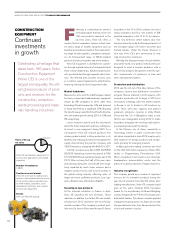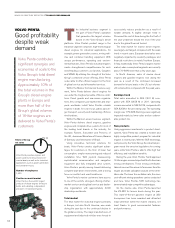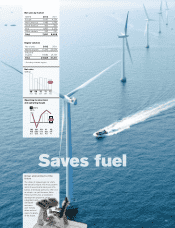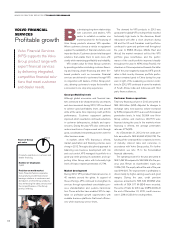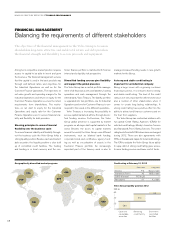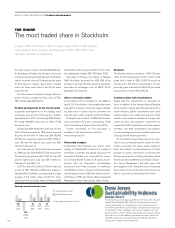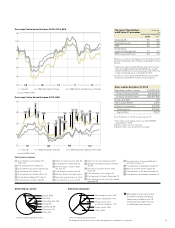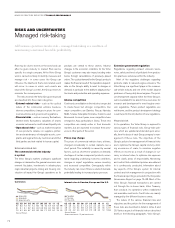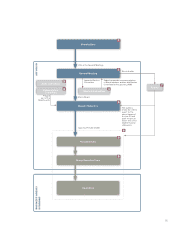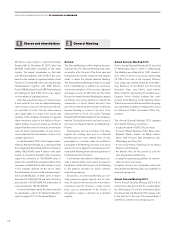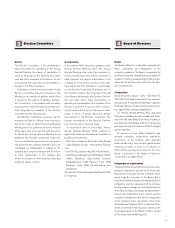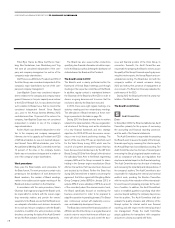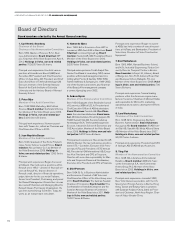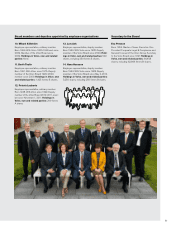Volvo 2012 Annual Report Download - page 76
Download and view the complete annual report
Please find page 76 of the 2012 Volvo annual report below. You can navigate through the pages in the report by either clicking on the pages listed below, or by using the keyword search tool below to find specific information within the annual report.
BOARD OF DIRECTORS’ REPORT 2012 GROUP PERFORMANCE
Extensive government regulation
Regulations regarding exhaust emission levels,
noise, safety and levels of pollutants from produc-
tion plants are extensive within the industry.
Most of the regulatory challenges regarding
products relate to reduced engine emissions. The
Volvo Group is a significant player in the commer-
cial vehicle industry and one of the world’s largest
producers of heavy-duty diesel engines. The prod-
uct development capacity within the Volvo Group is
well consolidated to be able to focus resources for
research and development to meet tougher emis-
sion regulations. Future product regulations are
well known, and the product development strategy
is well tuned to the introduction of new regulations.
Financial risk
In its operations, the Volvo Group is exposed to
various types of financial risks. Group-wide poli-
cies, which are updated and decided upon annu-
ally, form the basis of each Group company’s man-
agement of these risks. The objectives of the
Group’s policies for management of financial risks
are to optimize the Group’s capital costs by utiliz-
ing economies of scale, to minimize negative
effects on income as a result of changes in cur-
rency or interest rates, to optimize risk exposure
and to clarify areas of responsibility. Monitoring
and control that established policies are adhered
to is continuously conducted. Information about
key aspects of the Group’s system for internal
controls and risk management in conjunction with
the financial reporting is provided in the Corporate
Governance Report on page 74–88. Most of the
Volvo Group’s financial transactions are carried
out through the in-house bank, Volvo Treasury,
that conducts its operations within established
risk mandates and limits. Credit risks are mainly
managed by the different business areas.
The nature of the various financial risks and
objectives and the policies for the management of
these risks are described in detail in notes 4 and
30. Various aspects of financial risk are described
briefly in the following paragraphs. Volvo Group’s
RISKS AND UNCERTAINTIES
Managed risk-taking
Risk may be due to events in the world and can
affect a given industry or market. Risk can be
specific to a single company. At the Volvo Group
work is carried out daily to identify, measure and
manage risk – in some cases the Group can
influence the likelihood that a risk-related event
will occur. In cases in which such events are
beyond the Group’s control, the Group strives to
minimize the consequences.
The risks to which the Volvo Group are exposed
are classified into three main categories:
• External-related risks – such as the cyclical
nature of the commercial vehicles business,
intense competition, changes in prices for com-
mercial vehicles and government regulations.
• Financial risks – such as currency fluctuations,
interest levels fluctuations, valuations of shares
or similar instruments, credit risk and liquidity risk.
• Operational risks – such as market reception
of new products, reliance on suppliers, protec-
tion and maintenance of intangible assets, com-
plaints and legal actions by customers and other
third parties and risk related to human capital.
External-related risk
The commercial vehicles industry
is cyclical
The Volvo Group’s markets undergoes significant
changes in demand as the general economic envi-
ronment fluctuates. Investments in infrastructure,
major industrial projects, mining and housing con-
struction all impact the Group’s operations as its
products are central to these sectors. Adverse
changes in the economic conditions for the Volvo
Group’s customers may also impact existing order
books through cancellations of previously placed
orders. The cyclical demand for the Group’s products
makes the financial result of the operations depend-
able on the Group’s ability to react to changes in
demand, in particular to the ability to adapt produc-
tion levels and production and operating expenses.
Intense competition
Continued consolidation in the industry is expected
to create fewer but stronger competitors. Our
major competitors are Daimler, Paccar, Navistar,
MAN, Scania, Caterpillar, Komatsu, Cummins and
Brunswick. In recent years, new competitors have
emerged in Asia, particularly in China. These new
competitors are mainly active in their domestic
markets, but are expected to increase their pres-
ence in other parts of the world.
Prices may change
The prices of commercial vehicles have, at times,
changed considerably in certain markets over a
short period. This instability is caused by several
factors, such as short-term variations in demand,
shortages of certain component products, uncer-
tainty regarding underlying economic conditions,
changes in import regulations, excess inventory
and increased competition. Overcapacity within
the industry can occur if there is a lack of demand,
potentially leading to increased price pressure.
All business operations involve risk – managed risk-taking is a condition of
maintaining a sustained favorable profitability.
Currencies Interest rates in Sweden, Europe and the U.S.
1005 06 07 08 09040302 11 12
9.7 8.0 7.3 7.5 7.4 6.8 7.8 7.2 6.7 6.9 6.5
9.1 9.1 9.1 9.2 9.3 9.3 10.9 10.4 9.0 8.9 8.6
7.3 6.7 6.5 6.7 5.8 5.8 8.6 7.7 8.3 9.0 7.5
Source: Reuters
SEK/100 JPY
SEK/USD
SEK/EUR
07
4.3
4.3
4.0
08
2.4
2.9
2.2
02
5.3
4.8
4.5
03
4.6
4.1
4.0
04
4.4
4.0
4.2
05
3.4
3.4
4.3
06
3.7
3.8
4.8
Source: Reuters
Government bonds, 10 year benchmarks
10
3.3
3.0
3.3
11
1.6
1.8
1.9
12
1.5
1.3
1.8
09
3.4
3.4
3.8
%
Sweden
Europe
The U.S.
72


